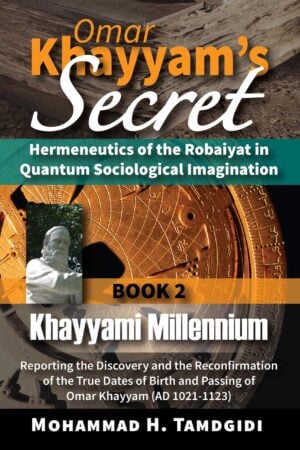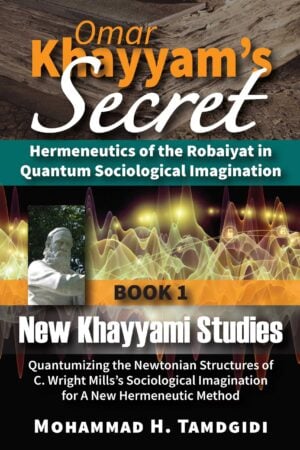Book Section: CHAPTER VI — Moayyed ol-Molk or Fakhr ol-Molk?: Who Requested Omar Khayyam’s Treatise on the Science of the Universals of Existence and When Was It Written? — by Mohammad H. Tamdgidi
$20.00
This essay, titled “Moayyed ol-Molk or Fakhr ol-Molk?: Who Was the Requester of Omar Khayyam’s Treatise on the Science of the Universals of Existence and When Was It Written?” is the sixth chapter of the book Khayyami Philosophy: The Ontological Structures of the Robaiyat in Omar Khayyam’s Last Written Keepsake Treatise on the Science of the Universals of Existence, which is the fourth volume of the twelve-book series Omar Khayyam’s Secret: Hermeneutics of the Robaiyat in Quantum Sociological Imagination, authored by Mohammad H. Tamdgidi.
Description
Abstract
This essay, titled “Moayyed ol-Molk or Fakhr ol-Molk?: Who Was the Requester of Omar Khayyam’s Treatise on the Science of the Universals of Existence and When Was It Written?” is the sixth chapter of the book Khayyami Philosophy: The Ontological Structures of the Robaiyat in Omar Khayyam’s Last Written Keepsake Treatise on the Science of the Universals of Existence, which is the fourth volume of the twelve-book series Omar Khayyam’s Secret: Hermeneutics of the Robaiyat in Quantum Sociological Imagination, authored by Mohammad H. Tamdgidi.
This chapter explores the identity of the person who invited Khayyam to write his treatise on the universals of existence, and when it was written. Until now, most scholars have routinely considered the name given for the requester of Khayyam’s treatise to be that of Fakhr ol-Molk, a son of Nezam ol-Molk, the famous vizier of Soltan Malekshah. This would also imply that the treatise could have been written as late as the years 500 LH. However, in Tamdgidi’s view, if we conclude that the treatise was requested by Moayyed ol-Molk and not Fakhr ol-Molk, another younger son of Nezam ol-Molk, the way the name and its title is rendered opens a whole new window for our understanding of the socio-historical context in which the treatise was written, implying as well that it could have been written about a decade earlier than currently thought.
Is it possible to consider that Khayyam, in the introduction to the treatise, by rendering the name and title of the requester as such, was providing a discreet hint at the rivalry between the two brothers, supporting Moayyed ol-Molk against his brother Fakhr ol-Molk? Khayyam’s honorary title for Moayyed ol-Molk as given in the introduction hints at his opinion that it was Moayyed ol-Molk who was to be regarded as the “Fakhr” (the pride) of the “Mellat” (the people) and of the “Din” (the faith or religion), and not his brother “Fakhr ol-Molk” (“pride of the land”).
In this chapter Tamdgidi argues that the consideration that the requester of Khayyam’s treatise was Moayyed ol-Molk and not Fakhr ol-Molk would significantly clarify and remove that ambiguity altogether and shed significant light not only on the historical and biographical context and chronology of Khayyam’s treatise’s writing, but even offer us deeper insight into the seemingly abstract and “universal” worldview Khayyam presents in his last treatise written for keepsake.
A summary of the findings of this chapter is as follows:
1. There can be little doubt, based on the textual clues and errors found in the extant copies of the manuscript, that the person who requested Khayyam’s treatise was Moayyed ol-Molk and not Fakhr ol-Molk, both being sons of Nezam ol-Molk.
2. Khayyam’s given honorary title “Fakhr ol-Mellat val-Din” for Moayyed ol-Molk in the introductory clause of the treatise indicates a deliberate, yet subtle and discreet, preference on his part in support of Moayyed ol-Molk over his brother Fakhr ol-Molk.
3. Since no customary God’s blessing wish for a deceased person is offered for Moayyed ol-Molk in Khayyam’s introductory clause, we should safely assume that the treatise was written on or before the year 494 LH (AD 1101), when Moayyed ol-Molk was executed by Soltan Barkiaroq.
4. Since it is unlikely that Khayyam would have discreetly, yet publicly, offered such a favorable honorary title for Moayyed ol-Molk over his brother Fakhr ol-Molk, given their being the sons of Khayyam’s own patron Nezam ol-Molk, it is safe to assume that the treatise was written at the request of Moayyed ol-Molk at a time it had become evident and common public knowledge that he had been betrayed by his brother Fakhr ol-Molk by way of the latter’s bribing those in the court of Barkiaroq, a son of Soltan Malekshah. So, the treatise must have been written at least soon after the removal of Moayyed ol-Molk from his vizier position in the court of Barkiaroq, which happened in the year 488 LH (AD 1095-96).
5. Since Khayyam refers to Moayyed ol-Molk as someone in a position of high rank, such as a vizier, with whom he had had frequent meetings, we should safely assume that at the time Khayyam wrote his treatise, Moayyed ol-Molk had been established as a vizier of Muhammad, a half-brother of Barkiaroq, both being rival sons of Malekshah.
6. It is possible to infer that the timing of his request from Khayyam must have been when Moayyed ol-Molk’s vizierhood in Soltan Muhammad’s court was in its beginning months, when he was making energetic and hopeful efforts to groom a well-regarded son of the late king (Soltan Malekshah). So, the year 488 LH is the highly plausible earliest date of writing of Khayyam’s “Treatise on the Science of the Universals of Existence.”
7. It is possible that the writing of this treatise was also accompanied or soon followed by Khayyam’s writing of Nowrooznameh (The Book on Nowrooz), as another effort to cultivate a Persian culture for the new king, Soltan Muhammad, to follow up on the developmental projects the late Soltan Malekshah had started, including the completion of the observatory in Isfahan, in which Khayyam had been involved as a team leader.
8. Both the treatise and Nowrooznameh (The Book on Nowrooz) (besides perhaps even a renewed emphasis on writing any Persian poetry he had already been involved in as a lifelong interest) may have been more fully engaged in when Khayyam was still in Isfahan, following the triumphant return of Soltan Muhammad to the city with the aid of Moayyed ol-Molk. It is at this time and place that Khayyam may have been regularly attending Moayyed ol-Molk’s gatherings, being encouraged by him to write down his worldview and his vision of society, as grounds for encouraging the new young king to adopt a more independent Persianized path in uniting and ruling the land, its people, and faith.
9. From the above, it can be firmly concluded that Khayyam’s “Treatise on the Science of the Universals of Existence” was written many years before Ghazali’s book “Savior from Error” (dated 500 LH). In fact, considering that Khayyam’s treatise was written in the year 488 LH points to the possibility that the treatise itself may have at least partly influenced Ghazali’s spiritual self-questioning in that year, amid the crisis he found himself in politically and occupationally, and in fear of his own life, in the aftermath of the deaths of Nezam ol-Molk and Soltan Malekshah, in the year 485 LH, just a year after he had arrived (in 484 LH) at Baghdad to lead teaching efforts at the Nezamieh school in that city.
10. It is most likely that Ghazali’s book “Savior from Error” was written under the pressure and by invitation of Fakhr ol-Molk and Ahmad Sanjar, both having a dislike for Khayyam for one or another personal reason. Sanjar’s dislike went back to his childhood grudge against Khayyam’s having lost faith in his health or character, and Fakhr ol-Molk for Khayyam having discreetly, yet obviously to him, sided with his brother Moayyed ol-Molk, a brother who Fakhr ol-Molk had betrayed through bribery, leading eventually to his being executed by Barkiaroq a few years later. Khayyam could not have been indifferent to what he witnessed happening, sadly, between the two sons of his own patron Nezam ol-Molk, and clearly he sided with the son who was skilled, ambitious, and independent-minded enough to chart his own path in the style of his deceased father Nezam ol-Molk. Given the role Fakhr ol-Molk played in betraying his brother, leading in time to his death by Barkiaroq who had originally benefited from Moayyed ol-Molk to gain power, it simply seems inconceivable that Khayyam would dedicate his most important last keepsake treatise to Fakhr ol-Molk.
11. From the above, it is possible to conclude that in the aftermath of the loss of his patrons Nezam ol-Molk and Soltan Malekshah in the year 485 LH, resulting in the loss of hope for the continuation of his scientific and observatory projects, Khayyam was behind the scenes quite active in supporting his preferred alternatives for the continuation of the same through the agency of patronage received from and given to Moayyed ol-Molk, the more capable son of the late grand vizier. This also challenges the view that Khayyam was a political quietist, but suggest that he was, in his own way, seeking actively to influence his society toward more independent directions.
12. The picture is then telling of a Khayyam who is in his own discreet way active politically in shaping the fate of his land, people and faith in more independent directions akin to the local culture, tradition, and history, rather than as one being imposed by outsiders. This may then offer an interesting clue about the “purpose” for which Khayyam says in his introduction he dictated his treatise on the science of the universals of existence. The treatise portrays God’s created existence as a self-reliant, self-reflective, and self-creative substance, one that cannot be reconciled with the view of a society based on oppression and rule of outsiders.
Recommended Citation
Tamdgidi, Mohammad H. 2021. “CHAPTER VI — Moayyed ol-Molk or Fakhr ol-Molk?: Who Requested Omar Khayyam’s Treatise on the Science of the Universals of Existence and When Was It Written?” Pp. 249-278 in Omar Khayyam’s Secret: Hermeneutics of the Robaiyat in Quantum Sociological Imagination: Book 4: Khayyami Philosophy: The Ontological Structures of the Robaiyat in Omar Khayyam’s Last Written Keepsake Treatise on the Science of the Universals of Existence. (Human Architecture: Journal of the Sociology of Self-Knowledge: Vol. XVII, 2021. Tayyebeh Series in East-West Research and Translation.) Belmont, MA: Okcir Press.
Where to Purchase Complete Book: The various editions of the volume of which this Book Section is a part can be ordered from the Okcir Store and all major online bookstores worldwide (such as Amazon, Barnes&Noble, Google Play, and others).
Read the Above Publication Online
To read the above publication online, you need to be logged in as an OKCIR Library member with a valid access. In that case just click on the large PDF icon below to access the publication. Make sure you refresh your browser page after logging in.







